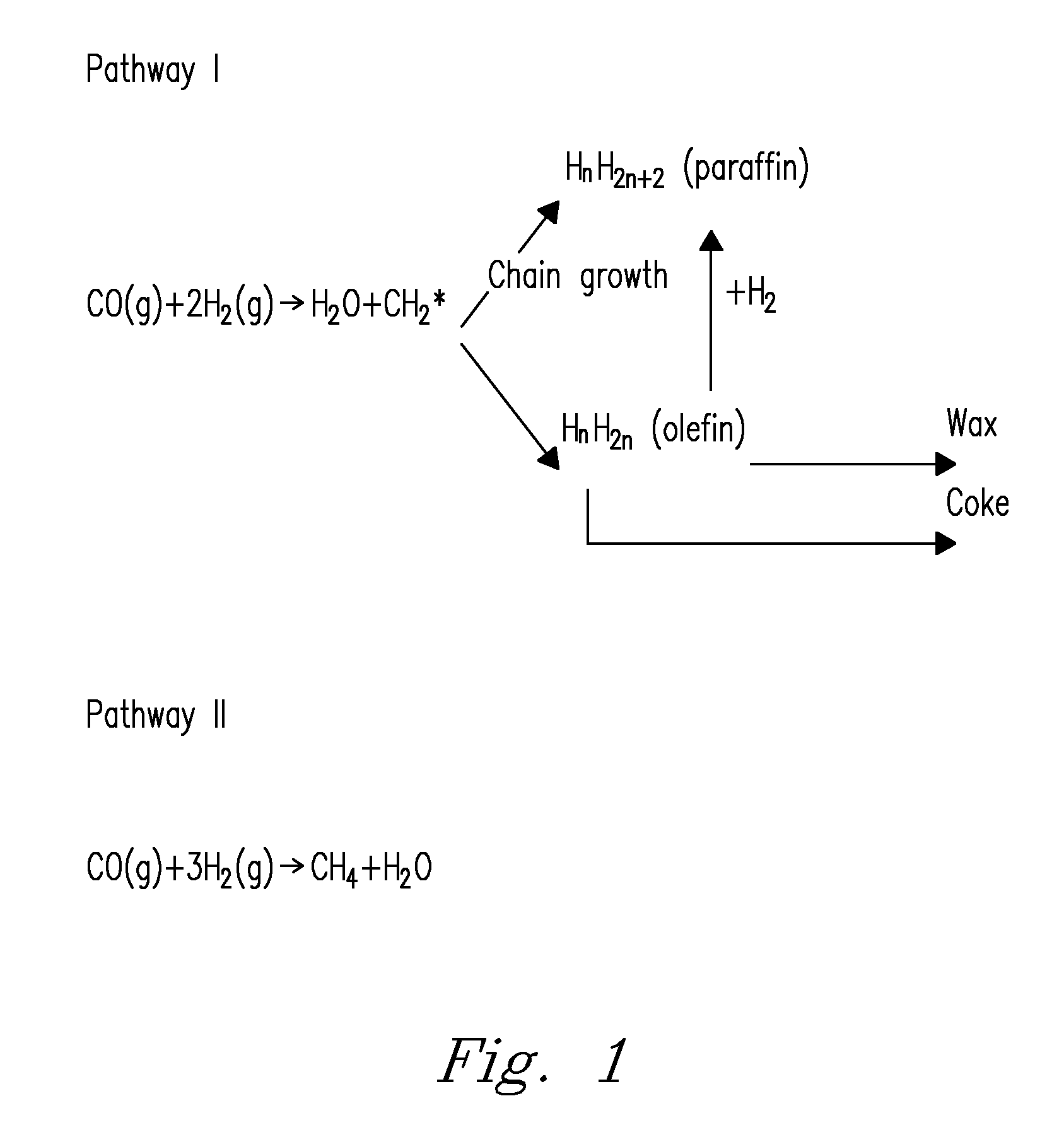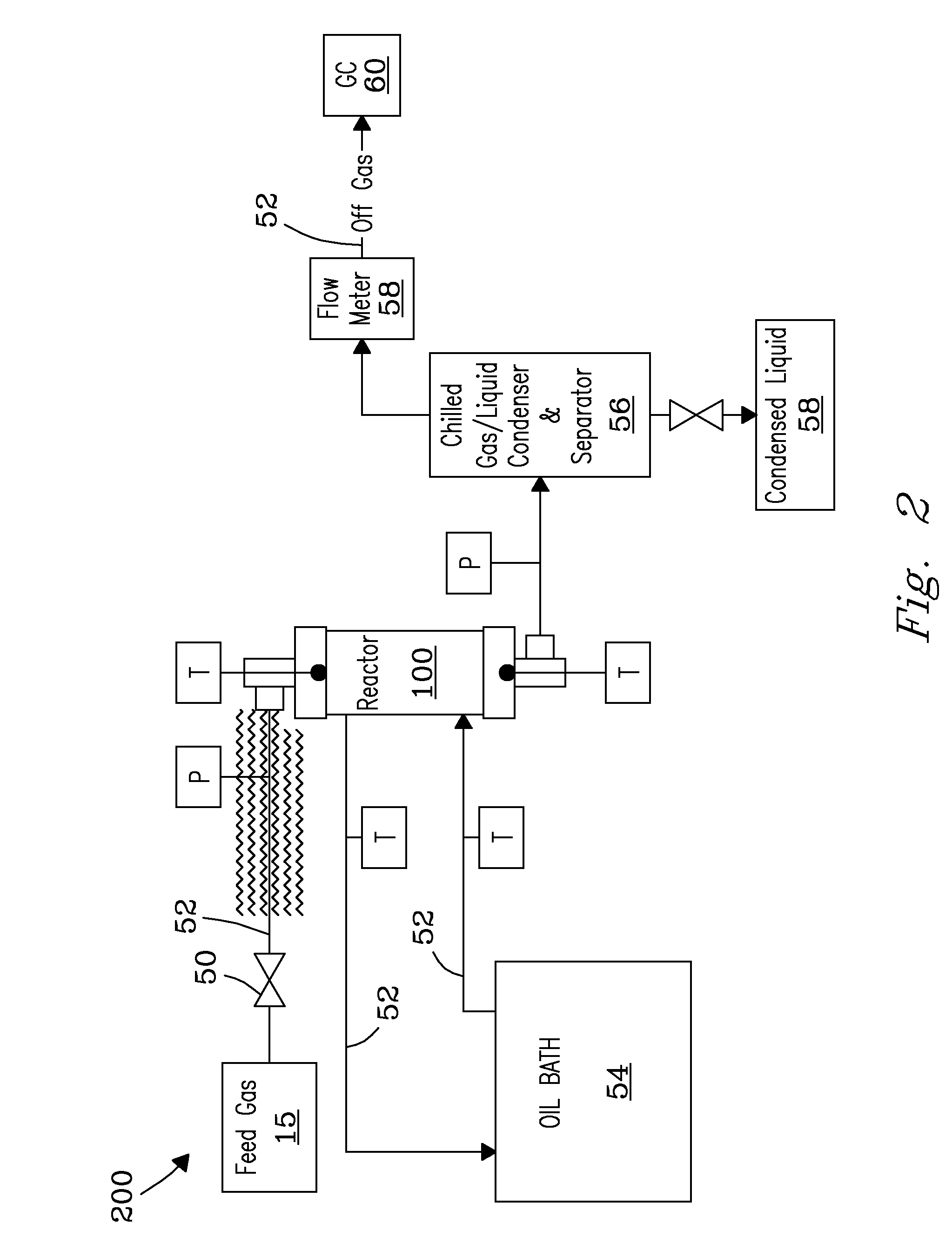Structured catalyst bed and method for conversion of feed materials to chemical products and liquid fuels
a structured catalyst and catalyst bed technology, applied in the direction of physical/chemical process catalysts, metal/metal-oxide/metal-hydroxide catalysts, hydrocarbon oil treatment products, etc., can solve the problems of enhanced hydrogenation, slow reaction diffusion limitation, and great challenge in enhancing yields to obtain products in the middle distillate range, so as to reduce ch4 selectivity and increase co conversion. , the effect of small increase in ch4 selectivity
- Summary
- Abstract
- Description
- Claims
- Application Information
AI Technical Summary
Benefits of technology
Problems solved by technology
Method used
Image
Examples
example 1
Preparation of Structured Monolith Catalyst
Wet Slurry Method
Coating Method I
[0057]Acidic γ-Al2O3 (Engelhard Corp., Iselin, N.J., USA) with a mean particle size of 45 μm was pre-calcined at 500° C. in air for 2 hours. An aqueous solution of cobalt nitrate hexahydrate (98% purity, Sigma-Aldrich, St. Louis, Mo., USA) and perrhenic (rhenium source) acid (53.29 wt % PM, Engelhard Corp., Iselin, N.J., USA) was prepared. The mixed metal solution was sequentially co-impregnated onto the γ-Al2O3 particles three times using a multi-step incipient wetness method. Catalyst particles were dried after each impregnation n air at 90° C. for 8 hours, followed by calcination at 350° C. for 3 hours. The sequential impregnation yielded a final formulated catalyst with 20 wt % Co and 4.5 wt % Re on Al2O3. A catalyst coating slurry was then prepared by ball-milling the above Co—Re / Al2O3 catalyst particles in de-ionized water for 24 hours. Next, the structured monolith catalyst module was prepared usin...
example 2
Preparation of Structured Monolith Catalyst
Wet Slurry Method
Coating Method II
[0058]Monolith, catalyst particles, and catalyst slurry were prepared as in EXAMPLE 1. The structured monolith was coated with catalyst by introducing the coating slurry at the bottom of the monolith substrate, which was pulled upward through the channels of the monolith under vacuum applied across the top of the monolith. After the monolith was completely soaked by the coating slurry for about one minute. Excess coating slurry was removed by centrifuging. The resulting, wetted monolith was dried at 110° C. for 6 hours, and calcined at 350° C. for 1 hour to affix the coating as a catalyst layer on the monolith substrate. The monolith support was a cordierite support with a cell density of 400 cpsi (# / in2) of 1-mm square channels. The monolith test pieces in cylindrical shape were core-drilled out of a full-size, oval-shaped monolith block. A catalyst coating slurry was prepared by ball-milling the above ...
example 3
Testing of Structured Monolith Reactors with Different Catalyst Loading Values
[0059]Weight fraction of C5-C18 hydrocarbons obtained in total liquid hydrocarbon products from conversion of CO at different reaction temperatures in a structured monolith catalyst reactor (FIG. 3) was compared with results to a (particle bed) control. Three different catalyst loadings were tested for FT reactions with the catalysts prepared from Example 1. In a first test of a structured monolith catalyst, the monolith ceramic piece was core-drilled to a size close to the diameter of the reactor tube (7.9-mm I.D.), fully loaded with catalyst, wrapped with a thin layer of ceramic wool, and plugged tightly into the reactor tube. The structured monolith had a catalyst layer thickness of 11 μm. In a second test of the monolith, 16 well-defined channels were introduced in the middle of the monolith piece and then loaded with catalyst. The structured monolith included a catalyst layer thickness of 6 μm. Chann...
PUM
| Property | Measurement | Unit |
|---|---|---|
| superficial linear gas velocity | aaaaa | aaaaa |
| size | aaaaa | aaaaa |
| thickness | aaaaa | aaaaa |
Abstract
Description
Claims
Application Information
 Login to View More
Login to View More - R&D
- Intellectual Property
- Life Sciences
- Materials
- Tech Scout
- Unparalleled Data Quality
- Higher Quality Content
- 60% Fewer Hallucinations
Browse by: Latest US Patents, China's latest patents, Technical Efficacy Thesaurus, Application Domain, Technology Topic, Popular Technical Reports.
© 2025 PatSnap. All rights reserved.Legal|Privacy policy|Modern Slavery Act Transparency Statement|Sitemap|About US| Contact US: help@patsnap.com



